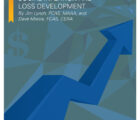 Let k = 10a where a = 101,000,000,000,000. Which number is larger, the kth root of k, k√k, or the (k+1)th root of k + 1, k + 1√ k + 1? What if k is some other positive integer?
Let k = 10a where a = 101,000,000,000,000. Which number is larger, the kth root of k, k√k, or the (k+1)th root of k + 1, k + 1√ k + 1? What if k is some other positive integer?
Know the answer? Send your solution to ar@casact.org.
 Multiply Them All Together
Multiply Them All Together
Intuitively, it seems like all the positive rational numbers, except 1, could be paired off as p/q and q/p, where p and q are coprime. Since the product of each of these pairs is 1, it would seem like when you multiply these infinitely many “pair 1s” together and then multiply by 1 itself, you would just get 1!
The problem is that when you actually line up all the positive rational numbers in an infinite sequence (prior to any “pairing”), you get infinitely long subsequences that diverge to +∞ or converge to 0, respectively. Since the logarithmic function is continuous on the positive real numbers, if the product of the rational numbers converged to a finite number other than 0, then the sum of the corresponding logarithms would also converge to a finite number. This is clearly impossible since this infinite sequence of logarithms will contain subsequences that diverge to +∞ or −∞, respectively. It is possible to form orderings of the positive rational numbers so that the product will either converge to 0 or “converge” (monotonically diverge) to +∞, respectively, which is an inconsistent and unsatisfactory answer!
Now, if q2 > 1 > q1 > 0, the same divergence problems happen for all the rational numbers in either of the intervals (q2, q1) or [q2, q1]. However, if 1 ≥ q2 > q1 > 0, then the product of all the rational numbers in either of these intervals clearly converges to 0. On the other hand, if q2 > q1 ≥ 1, then the interval products clearly monotonically grow larger beyond any limit, “converging” to +∞.
Solutions were also submitted by John Berglund, Bob Conger, Clive Keatinge, Chak Wai Lam, Eamonn Long, Tim Mosler, Anthony T. Salis, David Skurnick, J. Tyler Smith and William D. Volterman.













